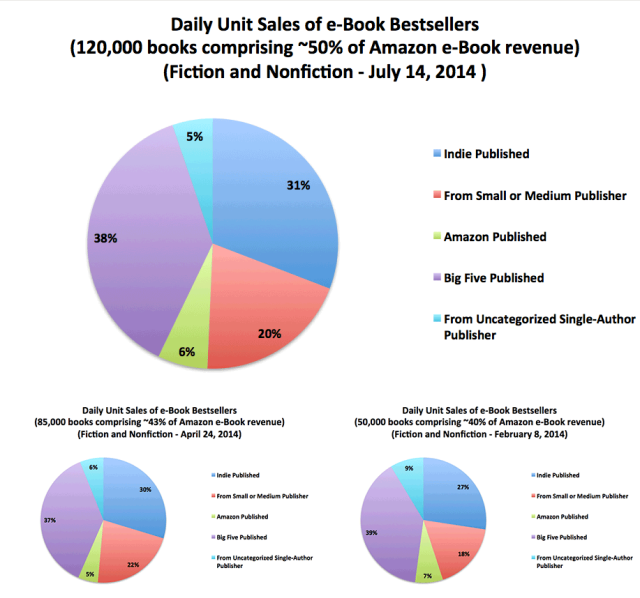The cat is out of the bag, finally we know exactly how many self-published authors make it big: 40.
Yes, that’s not a typo.
40 self-published authors “make money”, all the others, and they number in the hundreds of thousands, don’t. This interesting statistic, recently revealed in a New York Times article, applies to the Kindle Store, but since Amazon is in fact the largest digital publishing platform in the world, it is a safe bet that self-published authors are not doing much better anywhere else.
“Making money” here means selling more than one million e-book copies in the last five years. Yes, 40 authors have managed that, and have even gone on to establishing their own publishing house, like Meredith Wild. Her story is fully reported in the New York Times, here, and well worth pondering over. And wondering what “making money” really means.
That story reveals some further nuggets about the current fluctuating state of the publishing industry: it seems that last year, a third of the 100 best-selling Kindle books were self-published titles on average each week. Conversely, that means legacy publishers only raked in two-thirds. Perhaps this is not such a surprising result, given their habit of pricing e-books at stratospheric levels, from $12 to $16 or more compared to self-published authors who deem that $3 to $5 is the “right” price…One has to wonder why publishers do this, even at times pricing e-books more than their own printed versions of the title. Perhaps they are afraid of digital?
The digital market is indeed scary, primarily because of its dimension: over 4 million titles today in the Kindle Store, compared with 600,000 six years ago (again, the data is from the same article). This means “book discovery” has become the number one problem. How can your book stand out in such a vast crowd?
There are many answers in the industry (and savvy marketing certainly has big role), but some of the more ground-breaking solutions come from the successful self-published authors themselves, like Meredith Wild and a few others that have (more or less) followed her example, like Bella Andre, Barbara Freethy, H.M.Ward, C.J.Lyons. They have struck deals with Ingram Content Group, a major book printer and distributor, thus getting their novels in bookstores, big-box stores and airports. Because,let’s face it, when you’re selling big in the digital market, you don’t want to lose out in the printed one: 36% of book buyers still read only print books (according to a 2015 Codex Group survey – for more about how print books hold their own, see this article).
What does this mean in terms of the future of the industry? According to David Montgomery of Publishing Technology:
“There isn’t one book market anymore: there are two, and they exist in parallel. One continues to be dominated by major publishers, and increasingly uses agency pricing as a strategy to support print book sales. The second publishing market is almost exclusively made up of e-books, and is driven by Amazon-published and KDP content sold at a substantial discount to the product produced by traditional publishers.”
And he foresees a growing divide in 2016 between the two markets. Yet the success of Meredith Wild and the other authors like her suggests that something else might be happening: self-publishing could be encroaching in a territory that used to be seen as exclusive to legacy publishers.
Time to celebrate? Not yet. There is a caveat and it’s a big one: only 40 such authors are likely to bridge the divide. In fact, writing is a poor man’s occupation. As Publisher’s Weekly noted in an article published last year: the majority of authors earn below the poverty line. The statistics are grim:
Given that a single person earning less than $11,670 annually sits below the poverty line, 56% of respondents would qualify, if they relied solely on income from their writing. The survey also indicated that not only are many authors earning little, they are, since 2009, also earning less. Overall, the median writing-related income among respondents dropped from $10,500 in 2009 to $8,000 2014 in 2014, a decline of 24%. (highlight added).
That’s way below the poverty line! Small wonder that most authors depend on another job to survive…
So if you’re not selling your books, take heart, you’re not the only one. If you’re considering becoming a writer, think twice, it won’t make you rich. To be honest, if I could do my life over, I wouldn’t go into writing (though I love story-telling), I’d go into…film making! That is the art of the future, people don’t read books, they go to the movies, they binge on TV series, they play video-games. And in all these – movies, TV, games – good story-tellers are more needed than ever…
No, the art of writing is not dead, it is just undergoing a change of venue!
NOTE: This was published over a year ago and has garnered more comments than any of my blog posts has ever done before and I warmly thank my commentators including those who didn’t agree with my reading of the data – no doubt this avalanche of comments is a testimony to the (high) number of writers (self-published and non) wondering where they stand and what they can expect from a writing career. Bottom line: if you enjoy writing, just do it and don’t worry whether it’s going to bring in the bacon or not. One thing is will do for sure: it will make you happy. And that’s worth far more than any money you might ever make…Happy writing!




























